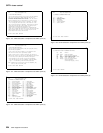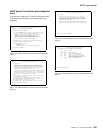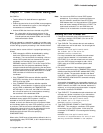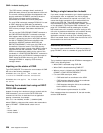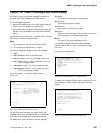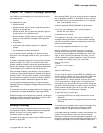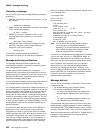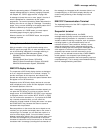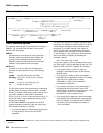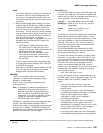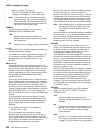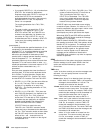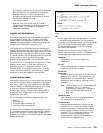CMSG—message switching
Canceling a message
You can cancel your current message-switching transaction
by entering:
CANCEL as the last 6 characters of your input. You get
the response:
TERMINATED BY OPERATOR.
CMSG as your first 4 characters, followed by end-of-data
(EOD). You get the response:
NO INPUT - REENTER.
CMSGx as your first 5 characters, where x is any
character other than a space or a C. You get the
response:
SPACE MUST FOLLOW TRANSID.
CMSG as your first 4 characters followed by a space
and EOD. This starts a new message-switching
transaction. You get the response:
CONTINUE INPUT.
The first three examples in this list terminate the
conversation and allow you to enter other transactions.
Message-switching continuation
The message-switching transaction appears to be
conversational. Internally, a new task is created to process
each message switching input.
If a task requires more information to complete the
transaction, the current status of the transaction is saved in
temporary storage, a response is sent to your terminal, and
the task terminates with a requirement that the next task
started be a message-switching task.
The saving of status replaces any previously saved status for
any message-switching transaction from that terminal.
If a message-switching transaction completes successfully, or
you have canceled it, an appropriate response is sent to your
terminal, the status of the transaction is not saved, and the
task terminates with no transaction restart specified. The
saved status is always used by a message-switching task to
continue a conversational input from your terminal. You can
recall the saved status by entering the transaction identifier
to which you have added C (for example CMSGC). You can
include additional input, but it must follow CMSGC with no
intervening spaces.
This method is useful because you can enter CANCEL to
bypass errors in the current input and yet not allow the
conversation to continue. You can then enter, for example
CMSGC and then enter EOD, which puts the terminal in the
conversation that prevailed at the time of the most recent
input that has not been canceled or has not resulted in a
message being routed. At this point you could also add an
option if desired, for example CMSGCT=1030. (Note that
there are no spaces between the transaction identifier, the C,
or the following data.)
For example, enter:
CMSG R=(T4,T41)
and you receive:
R OK CONTINUE INPUT,
T=15
RT OK CONTINUE INPUT
'THERE WILL BE ....... AT THE
RT OK CONTINUE MSG
MAIN NIO;FOMH PM VS;OGPTMOS SBR, CANCEL (see Note)
TERMINATED BY OPERATOR
CMSGCMAIN BUILDING ON CALIFORNIA AVENUE
RT OK CONTINUE MSG
IN ROOM 47',SEND
MRTS OK MESSAGE HAS BEEN ROUTED
Note: You can cancel and reenter instead of trying to
correct the input. This terminates the entire
transaction. To save the previously entered input,
enter CMSGC to restart at the previously saved
status point and continue the message.
Your terminal is free between a message-switching response
and the next input, and if it is in TRANSCEIVE status, an
automatically initiated task can be started on your terminal
before you can continue the message-switching transaction.
Upon completion of this new task, even if it required a
response from you, the message-switching transaction
continues as if nothing had intervened. However, if you
receive a response indicating that the intervening task has
issued a RETURN, you must enter the transaction identifier
followed by C to force continuation of the previous
message-switching transaction.
Message delivery
You can deliver a message to a destination if the following
conditions are met:
The specified delivery time has been reached
The terminal is INSERVICE, and either:
– The opid of the operator signed-on matches the
requested opid if specified in the ROUTE option
or
– The class of the operator signed-on matches any
class specified by the OPCLASS option.
The processing and paging status of a terminal, which also
affects delivery of eligible messages, is initially specified on
the CEDA DEFINE TYPETERM command. You can change
the status using the CEMT, CEST, and CEOT transactions.
When the processing status is RECEIVE or TRANSCEIVE, a
message is sent automatically to the terminal when no
transaction is attached to it.
232 CICS Supplied Transactions



